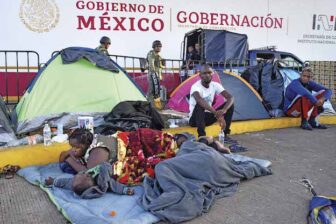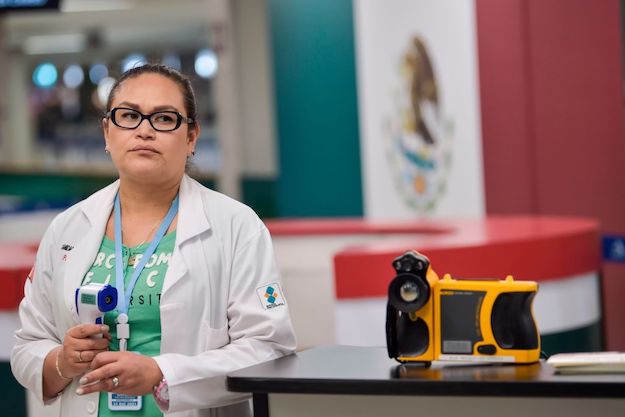This article is adapted from AQ’s special report on migration | Leer en español
TAPACHULA, Mexico — The modern name and whitewashed façade of the Siglo XXI (21st Century) “migration station” belie the nightmarish conditions migrants endure inside.
Several who passed through the facility during their quest for asylum in Mexico told AQ about diarrhea-inducing food, filthy bathrooms and sleepless nights, a Haitian woman getting roughed up for not understanding orders in Spanish, and the constant fear of an apparently arbitrary 4 a.m. wake-up call to face deportation. At least three migrants have attempted suicide inside the building since 2018.
“People come out of Siglo XXI reduced to scraps,” said Verónica Martínez, a psychologist at the Fray Matías Human Rights Center in Tapachula.
Trauma is a common thread for the Central Americans, Cubans, Haitians, West Africans and others who come through this city of 350,000 near Mexico’s border with Guatemala. Experts say the mental health of migrants is only starting to receive the attention it deserves — and will likely be a major issue for them, and host countries, for years to come. “It takes a lot of work to regain the humanity of people who came here with aspirations but are treated like they’re nothing,” said Martínez.
The scale of the problem is alarming at a time when Mexico has seen a surge of new arrivals fleeing violence and persecution in Central America and elsewhere. Trauma can happen before, during and after the journey. More than 55% of migrants who underwent screenings at a Doctors Without Borders (MSF, for its initials in French) facility in northern Mexico in 2019 showed moderate or grave signs of psychological suffering, according to a recent report published by the organization. Most of those cases were triggered by violence.
Néstor Rubiales, who runs MSF’s mental health program in Mexico, told AQ that around 10% of migrants they treat for mental health issues are in need of pharmaceutical care. Those findings fit with studies from elsewhere in the region. A recent paper by researchers from Harvard Medical School and Peru’s Universidad del Pacífico, which surveyed Venezuelan migrants at the Peru-Ecuador border, found that 19% showed signs of depression and 23% of anxiety.
But when it comes to mental health, money, attention and — at times — good will are in short supply. Funding services for migrants in a region where psychological support for the general population is overlooked can be a tough sell. Despite a more than 2,000% increase since 2015 in its annual number of asylum requests, the budget of the Mexican Committee for Refugee Assistance (COMAR) for 2020 is still just $2.38 million, a fraction of which is reserved for mental health services.
That migrants tend to be forward-looking and determined to solve their own problems, along with the stigma of “going crazy,” surely stops some from seeking help. The result in Tapachula is that government and civil society are struggling to keep up — and a growing number of migrants are at risk of falling through the cracks.
Stuck in limbo
Alquidia Nuñez, a 34-year-old from Honduras, arrived in Tapachula earlier this year with her two young daughters. Like many other migrants, she found that security on Mexico’s southern border had become more robust, a response to the Donald Trump administration’s threat to apply tariffs on Mexican products if the government didn’t stem the flow of migrants passing through its territory.
Migration officials and National Guard units now guard the Suchiate River that divides Mexico and Guatemala to stop migrants from bypassing official border crossings nearby. Additional checkpoints on the road toward Tapachula and a countrywide crackdown on undocumented migration have reduced travelers’ odds of making it to the U.S. border without first going through Mexican migration proceedings. For Nuñez, that meant a stay at Siglo XXI while officials decided whether or not she’d be allowed to apply for asylum.
In 2019, more than 70,000 people applied for asylum in Mexico — up from just over 2,000 five years earlier. When their requests are approved, applicants can legally travel to the northern border, but in the meantime they are forced to remain in the same Mexican state in which they arrived. More than 60% end up in Tapachula.
The surge in requests means migrants are regularly spending far longer in the city than the 45 days COMAR is given to process their claims. One Cuban asylum-seeker who had spent more than 10 months waiting for a decision told AQ that he was being “tortured with bureaucracy.”
“We try to help people get into a position where, when a decision finally does come, they are either strong enough mentally to handle a ‘no’ or able to plan ahead if they get a ‘yes,’” said Yamel Athie, a psychologist at Jesuit Refugee Services (JRS) in Tapachula, which, like Fray Matías, provides mental health and legal assistance to asylum-seekers.
With few job prospects and their social networks left behind, many migrants in Tapachula are stuck in limbo — too close for comfort to the places and, often, the people from which they fled. Nuñez left Honduras after her daughters’ father was shot and killed. For Central American women like her, especially, crossing the border to Mexico is no guarantee of safety from the gangs or even the individuals who threatened them back home.
The risks for women and children — who make up an increasing share of asylum requests — are acute. As many as a third of female migrants become victims of sexual abuse after crossing into Mexico, according to an MSF survey. Reported sexual abuse of minors in the state of Chiapas, where Tapachula is a main economic driver, rose by 60% in 2019.

“Everyone talks about the women being killed in Juárez (on the northern border), but nobody talks about the women being killed at the Suchiate River,” said Athie, who was born and grew up in Tapachula.
With only a handful of psychologists and psychiatrists available to treat patients in the city, migrants have few opportunities to try to come to terms with what they’ve experienced. Stigmatized and vulnerable, many female migrants fall into sex work or rely on fellow male migrants for protection, which carries its own risks.
“Migrant women repeatedly hear that they are here to be prostitutes or to steal other women’s husbands,” said Martínez. “This kind of psychological violence builds on itself and many of these women lose sight of a way forward.”
Trying to turn the page
Mexico has one of the highest asylum acceptance rates in the world, but the government’s response to changing migration has been fickle and uneven. After first promising safe passage to incoming migrants, President Andrés Manuel López Obrador is now accused, even by some in his own party, of militarizing Mexico’s southern border.
Following a recent trip to Tapachula, Porfirio Muñoz Ledo, a congressman with the governing Morena party, described the National Migration Institute (INM) that runs Siglo XXI as the Mexican government’s “firm, hairy hand” — the agency that migrants are made to fear and obey.
Other congress members who visited the facility said they believed officials had done a good job given the overwhelming influx at the southern border. A spokesperson for INM told AQ that the agency had invested 336 million pesos (about $14.5 million) since July 2019 to improve migration centers, and that Mexico’s human rights commission and U.N. agencies had monitored conditions at Siglo XXI.
COMAR, for its part, has psychologists on staff and offers free services to asylum-seekers. Andrés Ramírez, a former U.N. migration official who has headed the agency since 2018, told AQ that new hires and cooperation with international organizations will help speed up the application process and allow for better services for incoming migrants, especially those who don’t speak Spanish.
Still, the daily lines and handful of people sleeping on the sidewalk outside COMAR’s offices in Tapachula each night show how much is left to be done.
“The work will never be complete — because the refugee situation is constantly evolving,” said Ramírez. “But we are clear about what we need to change … we came in with a different perspective (from previous administrations), oriented more toward human rights.”
The Mexican government also offers some job programs — López Obrador recently said he would provide 4,000 jobs to migrants on the southern border. But that pales in comparison to the more than 40,000 asylum-seekers who arrived last year in Tapachula alone. And, given the traumas of migration, expecting migrants to simply show up and be productive employees may be unrealistic.
“These aren’t lost people, but we have to change what we’re providing,” Meghan López, who runs the International Rescue Committee’s Latin America office, told AQ. “It’s not as simple as saying ‘There, you have a job, now we’re done.’”
The most creative solutions are coming from civil society. MSF uses WhatsApp and phone calls to provide mental health check-ups for migrants on the move. JRS hosts women’s support groups and provides free mammograms and HPV prevention services, reserving 50% for Mexican citizens to avoid feeding resentment among those who feel migrants’ needs are being given priority over their own.
Still, civil society and international organizations have resource restrictions of their own — and long-term treatment remains a challenge. Athie told AQ she was cautious about suggesting migrants seek psychiatric or pharmaceutical care — even if they are in need — because keeping up with treatment during migration can be logistically and economically next to impossible.
“We can accompany people in their treatment for awhile, but eventually they are going to move on,” she said. “There just aren’t enough of us.”
—
Russell is a senior editor and correspondent in Mexico City for AQ









